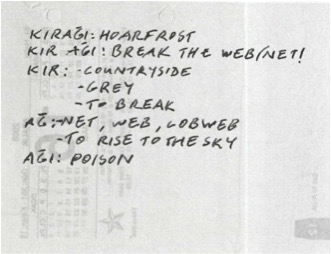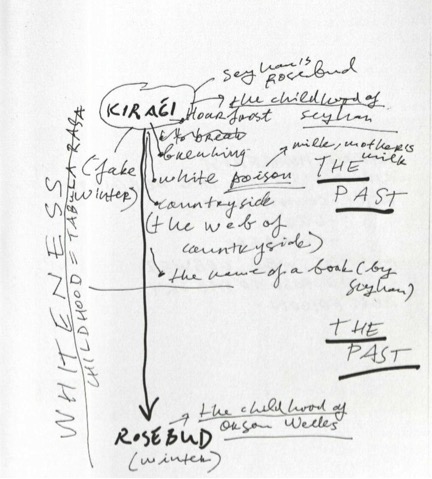A word's autobiography
Seyhan Erözçelik's 'KırAğı' and 'Rosebud'

After Seyhan Erözçelik: Dedicated to the Word “Kırağı”
Frost first
force fast
slow
fist farce (course)
lost
blow
— Murat Nemet-Nejat
Kır Ağı (Hoarfrost) is Seyhan Erözçelik’s third published book, but if we look at the dates when these poems were composed, we see that it is actually the first book he wrote, published eleven years after these poems were initially written. Seyhan Erözçelik was in his late teens when he wrote Kır Ağı, which took him about three years to finish (1980–83). Most of the poems in this book are about the development of his distinct vision of language, a vision “disguised” as a childhood narrative. He plays with words and creates new constructs. These constructs have a pictorial quality, and could also be regarded as poetic ideograms. The title Kır Ağı is a made-up construct. Throughout the book, Erözçelik creates juxtapositions between the literal and the etymological meanings of certain words. These juxtapositions cause semantic dislocations and friction, and the child narrator/poet turns this friction into fiction, an imaginary mélange of etymological constellations that create a narrative. In the poems that we will mention here, Erözçelik’s syntax is broken, and it is possible to read the poems in many semantic combinations. Variant meanings of a particular word are not suppressed — instead, the syntax encourages the reader to try out different meanings of a single word in order to solve the poetic puzzle. Erözçelik’s words are open to any kind of connotation that words may entail; therefore, reading these poems is also a form of divination. It is a practice in which one could follow different circuitous etymological combinations which give life to his innovative vocabulary.
Spaces of a verbal construct
A word/image in Erözçelik has three dimensions: semantic, visual (diagrammatic), and narrative. They weave a complex that is at the center of his poetry. The development of a single expression, “kır ağı,” over the course of Erözçelik’s work illustrates this process well.
“Kır ağı” reappears in a poem later in Erözçelik’s œuvre, “Rosebud” (which appears at the end of this essay), where it is transformed into the single word “kırağı.” The expression/word has multiple connotations in Turkish. Many of Erözçelik’s readymade words contain complex structures of meanings which act as ideograms, ideogram-words. He was known to be an avid collector of objects, and as he did with words, he created many readymade objects, which he elegantly displayed in his home.
Erözçelik derives this sense of multilevel complexity from the nature of Turkish as a language. Turkish borrows from many different languages. The Ottoman Turkish has a rich array of vocabulary deduced from Arabic, Persian, Italian, Greek, Armenian, and Serbian. Ottoman Turkish introduced new words which combine Persian, Arabic, and Turkish conventions. Root words might be originally taken from Arabic, but a Persian or a Turkish suffix could be added to create a new word. But the source of this linguistic imagination is not limited only to foreign borrowings; it also derives from the nature of Turkish as a central Asian, agglutinative language. Original Turkish has a relatively small vocabulary[1] and, because of its principle of vowel harmony, a narrow sound range.[2] Because of that, many words, in different declensions, share the same sound. As a result, the Turkish sentence, in the hands of poets such as Eröçelik and Ece Ayhan, possesses an alternate, suppressed, nonlinear syntax — opening to an elusive dimension in the reader’s mind, where alternate meanings of sounds connect freely.
The Semantic Break Into Visual Space: “Kırağı” to “Kır ağı”
Eröçelik drew two diagrams for Murat Nemet-Nejat, one of them in a coffee shop in Istanbul, to explain the multiple meanings of “kır ağı”/ “kırağı”[3]:

“Kırağı” literally means “hoarfrost.” For Erözçelik, seeing a frost is not a Proustian moment, characterized by images and memories, but something that is more etymological and linguistic in character: seeing a frost takes Erözçelik back not to his childhood memories, but to his childhood vocabulary, a web of contradictions between elation, thrill, ascension and fall, destruction, dying that the word embodies. That is to say, Erözçelik does not code the word kırağı as a poetic image, but splitting it (“kır ağı”) opens it to a conflux of ideas and feelings in which a narrative is buried.
Rosebud: “Kırağı” as narrative

“Rosebud” is the penultimate poem in Rosestrikes and Coffee Grinds, in the “Rosestrikes” section, which consists of a sequence of forty-seven poems, the majority of which have a verbal construct in their titles created by compounding the word “rose” with another word (“Swimrose,” “Beerose,” “Rosemountain,” “constellationrose,” etc.). In the poem, a boy goes out very early in the morning to a field that is covered in hoarfrost. Like other kids, he begins to crush the web of ice with his heel. The pleasure, the thrill that this experience evokes is accompanied suddenly, and mysteriously, by a sense of panic, trauma, and alienation — the self splitting from itself (“Frost bitten / I, his innocent face / in its most fiend tormented form”). The poem explores the relationship between these contrary forces.
As the ideograms show, this contradiction is embedded, as a spiritual force, within the etymological structure of “kırağı” itself. Ascension, whiteness (winter), thrill of breaking the web coexist with the idea of hoarfrost (false winter), poison, dying, etc. In other words, the primary subject of the poem is not a literal childhood memory (that is only a MacGuffin), but a spiritual mystery, in the shape of a narrative, buried in the word itself. Narrative — as if a reflection from a mirror — emanates from it, not from personal biography or memory. Eröçelik’s “Rosebud” is the biography of a word, the spiritual mystery it embodies — a field of ideas where paradise (the Sufi “arc of ascent”) and fall (the “arc of descent”) are simultaneous — creating a poetry where word, idea (spirit), narrative, and vision are one.
Here lies the stunning originality of Erözçelik’s poetry. Within the Turkish context, it breaks away from the İkinci Yeni (the Second New) poets of the 1950s, who are arguably the most widely read poets in Turkey today. The Second New eliminates metaphor as a unit of poetry, relying on obsessive uses of imagery that often turn the poetry into a manic kaleidoscopic display of striking, often semantically ambivalent sets of words. Its impact is to reveal what is politically suppressed and sexually forbidden.[4] In the sensual-visual sense, images are rare in Erözçelik’s poetry. Images (words) are basically spiritual ideograms that visually move across the page continuously arranging and rearranging themselves. They form dynamic poems of ideas — thought as words and words as thought — as the title of this poem indicates, reminiscent of film.[5]
Within the wider framework of poetry in general, Erözçelik creates a poetry of ideas where word is plugged into spirit, through the eye and the ear, creating an inextricable whole, reminiscent of the dynamic motions in film. He is one of the precursors of a spiritual language in poetry derived from film language.
Appendix 1
I. A Personal Note
When I visited Erözçelik’s beautiful flat in Emirgan overlooking the Bosphorus to interview him about his poetry, he was eager to show me how he traced a particular word to its origins or found different calques existing in other languages. He worked with the precision of a philologist, but also never gave up his poetic imagination. His personal library had a great number of etymological dictionaries and encyclopedia written in different languages, from texts produced as early as the fourteenth century to recent scholarly works. One of his most loyal companions during his detective investigations was Meninski’s Thesaurus Linguarum Orientalium Turcicae — Arabico — Persicum Lexicon, a seventeenth-century work which includes the translations of the most common Ottoman vocabulary of the time in five different European languages. This early work gave Erözçelik the liberty to move from one language to another, and to create imaginary etymologies that could only be realized by a poet. Another key work for Seyhan Erözçelik is Tuḥfe-yi Murādī (The Book of Precious Stones) by the early fifteenth-century Ottoman scholar and physician Muḥammad ibn Maḥmūd al-Shirwānī. He used this book extensively in order to write his gemstone divination poems in one of his last poetry books Yağmur Taşı (Rain Stone) in 2004.
II.
Here is the grammatical account of the meanings of “kır ağı,” pointing to the explosive, multidimensional nature of Turkish — like “Alifs … double double double crossing”[6] — due to its being an agglutinate language with a narrow aural range. Turkish embodies Jack Spicer’s gnostic vision of a Martian/paradisiacal language that must have “an infinitely small” vocabulary where all meaning (all words) ultimately converge into one: “kır” is an adjective that is used for gray hair (“hoar”) and it is also the imperative of the verb “kırmak” in the infinitive, which means “to break” or even in some contexts “to crush.” “Ağ” without the genitive suffix “ı” (of) could mean “web” or “cobweb” as well as “network,” and it is also the imperative of the verb ağmak in the infinitive, which means “to ascend” (as Erözçelik writes in his unpublished notes, this notion of ağmak in the sense of “ascending” could be used to describe Jesus’s ascent to the sky after being crucified). So, in its most literal sense, a frost means a web of frozen dew, whereas in its most metaphorical sense, it may come to mean the imperative “Kır ağı!” (“Crush the net!”). The heels that crush the frost have also the sense of an Achilles’s heel, an outlet to vulnerability, because by breaking the reality of a frost, the child also comes across a sense of going beyond — trespassing a zone that is limited or already defined.
III. The Snow Globe: Divination of the Lens, Last Words, and “Rosestrikes” as Film
Erözçelik sees poetry as a form of divination that emanates from the mystery of language itself. In Gül ve Telve (Rosestrikes and Coffee Grinds), a book that Murat Nemet-Nejat made available in English in its entirety in a controversial translation,[7] we see that Erözçelik turns different methods of divination into poetry: in the “Rosestrikes” section, he writes his poems as if he is telling the reader’s (or listener’s) fortune using rose petals (phyllorhodomancy), and in this vein, the fragmented nature of the poems in this section are related to the visual aspect of casting rose petals, in which each fragmented stanza represents a petal that Erözçelik threw to the ground for prognostication.
In the center of Welles’s Citizen Kane lies the swirl of snowflakes inside a snow globe, the path/object through which Welles’s camera lens finally enters the mystery of Kane’s heart, a moment of childhood where Kane is unified with his mother, playing happily in the pristine snow with his sled Rosebud, just before he would lose her. This swirl of snow parallels the glittering fragments of frost/“alifs” that spread around in the field in “Rosebud,” crushed by the boy. The movement of the camera (revealing Kane’s secret) is like the movements of Erözçelik’s word fragments (in this case “kır ağı”) revealing the immutable, elusive secret at the heart of the word (of language itself) to the reader’s eye. A cinema of words is born.
While the mystery in Orson Welles’s film has an answer at the end,[8] buried in the protagonist’s past, the divination in Erözçelik’s poem remains a mystery: the complex of disseminating relationships surrounding a word. Welles’s film ends with the visual image of a sled named Rosebud. What Erözçelik’s poem ends with is the ideogram of a word itself (floating in the reader’s mind’s eye), word as a verbal cinema of mysterious space.[9]
Appendix 2: “Rosebud,” translated from Turkish by Murat Nemet-Nejat[10]
Rosebud
I. The Web
Dews are frozen. Therefore, a web breaker
Frost bit into my heel,
wherefore, didn’t I die?
Because frost is in my heart.
My soul is a website
When I was a kid, frost, crescently
sank into my heel,
mom said,
“it seems like the moon
frost sank into my heel.”
Then, I died.
That is, as a kid, once …
Mom said.
I won’t do it again.
said,
as a kid once I did.
I won’t die again
That is, if death were
a childhood disease.
Yet stung into my heel
it seems once
I did,
hit hit by frost
in my heel.
Then, then into my heart.
II. The Walk
“a brook hidden in lace …”
Frost is woven with straight lines, i.e., with alifs[11]
crossing each other. Manna pouring from above. Dust and frost
oppose, dust can’t reach
the manna state without
a pour.
Alifs neutralize dust. On earth, where there is dust,
revealing a new pattern.
Alifs, aslant each other.
Double double double crossing
Sunrise — and cold — is the best place to see it.
The span of frost’s life, crossing a kid’s
gleeful heel (that is
my heel) or as long as the sun’s heat.
Frost is alive within the moon,
pursuing its own pattern.
Frost!
A frog in the soul.
The daylight approaching, the kid steps on it.
The sky breaks down.
i’m in the web
The alifs turn to dust.
The alifs which cutting please my eyes spread to the ground
chasing me[12]
Frost bitten,
I, his innocent face
in its most fiend tormented form.
Meadow crush.
A kid’s rush.
III. The Rush
The meadow walking kid. Stinging nettles are blooming in my heart.
A kid, as me, that is my heel, crushed
the frost. Fragments of frost broke the weave
in the heart, cut it
loose. Frost gone, only the cut endures,
colder than steel. The theft. The heel probed
the dust, inside it
looking for something,
But all is pale, forlorn frost!
(I want to put my hook into your heart so that you can’t unhook me)
IV. The Crush
In the morning we faced a terrifying frost. Crushing frost and ice,
I saw
everyone else doing same.
As the rainbow pleases mankind,
so does, it seems, crushing frost.
Because the inside of frost is hollow, the sound it makes being crushed
is interesting.
(Eureka! Is that, in essence, Achilles’ scream?)
As if a piece of music.
Exactly like the crushing of a particularly thin glass.
Maybe of a crystal bone.
If you haven’t blown off already
forget this poem,
but not
me.
I
know
what youth
is.
1. Not exactly Jack Spicer’s vision of a paradisiacal language as one that has an “infinitely small” vocabulary, but close.
2. Vowels in Turkish are divided into open (a, ı, o, u) and closed (e, i, ö, ü). If the Turkish root of a word has an open vowel in the first syllable, the rest of the vowels are open also, and vice versa.
3. Both ideograms are included in Seyhan Eröçelik, Rosestrikes and Coffee Grinds, trans. Murat Nemet-Nejat (Greenfield, MA: Talisman House, 2010), 87–88, immediately preceding the poem “Rosebud.”
4. Ece Ayhan (1931–2002) reveals the sexual and ethnic underbelly of Istanbul and Cemal Süreya (1931–90) by introducing a sadomasochist eroticism that was historically integral to Turkish Spiritual folk poetry, but was absent in twentieth-century Turkish poetry before the 1950s. To learn more about the Second New, read the introduction “The Idea of a Book” to Eda: An Anthology of Contemporary Turkish Poetry, ed. Murat Nemet-Nejat (Jersey City, NJ: Talisman House, 2004); and Ece Ayhan, A Blind Cat Black and Orthodoxies,trans. Murat Nemet-Nejat (Los Angeles: Green Integer Press, 2015).
5. The walls of Erözçelik’s home were covered with film DVDs and records of old popular songs.His library included an encyclopedia of angels.
6. Eröçelik, Rosestrikes, 92.
7. Nemet-Nejat’s translations are controversial because there are originally forty-eight poems in Erözçelik’s Turkish Gül ve Telve, whereas in Nemet-Nejat’s translation of the same book there are sixteen additional poems that are not written by Erözçelik. Similar to what Jack Spicer does in his After Lorca, which includes many different pieces that Spicer has composed (including his letters to the deceased poet and additional duende poems inspired by Lorca’s Spanish verse, along with his fragmented translations from original Lorca lyrics), Nemet-Nejat includes sixteen new poems of his own. Murat Nemet-Nejat responds to the controversy by asserting that the additional poems arise out of the logic (dispersal/splitting) that is inherent to Erözçelik’s method (poetics) and that, therefore, they are true extensions (in Spicer’s terms, “correspondents”) of Erözçelik’s poems. In the “Afterword” to Rosestrikes and Coffee Grinds, Nemet-Nejat has a section devoted to Spicer’s idea of “correspondence” in translation and how Erözçelik’s sound structure necessitated the additional poems in English. Erözçelik knew what Nemet-Nejat was doing and was very happy with his poetry in its English incarnation. Once, while visiting the United States, Erözçelik said that his poems were like his children. Once they are born, they are on their own.
8. Citizen Kane is structured as a mystery. The film starts with the dying Kane letting go of a snowball from his hand while uttering “rosebud,” his final word. The dynamic of the film is to connect that word to the sled in the ball (not a phenomenological sled in the world).
9. This essay is partly the product of conversations over the years with Seyhan Erözçelik and Murat Nemet-Nejat on Erözçelik’s poetry and Nemet-Nejat’s translation of Erözçelik’s Gül ve Telve (Rosestrikes and Coffee Grinds).
10. Eröçelik, Rosestrikes,89–95.
11. “Alif” is the Hebrew letter “aleph” in Arabic. In Arabic it is written as a diagonal slash disappearing two-thirds down. “Aleph” is also a symbol for the infinite in Georg Cantor’s mathematics of transfinite sets.
12. The breaking and dissemination of frost as alifs on the grass is like the splitting of multiple meanings of a word on the page (“Bluntrose // the rose turned out to be blunt / the heart to // S M I T H E R E E N S!” Eröçelik, Rosestrikes, 78).